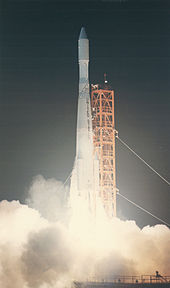Pioneer 6
| Pioneer 6 | ||||||||||||||||
|---|---|---|---|---|---|---|---|---|---|---|---|---|---|---|---|---|
 Artist's impression of Pioneer 6 |
||||||||||||||||
| NSSDC ID | 1965-105A | |||||||||||||||
| Mission goal | Investigation of interplanetary space | |||||||||||||||
| Client |
|
|||||||||||||||
| Launcher | Delta-E | |||||||||||||||
| construction | ||||||||||||||||
| Takeoff mass | 146 kg | |||||||||||||||
| Course of the mission | ||||||||||||||||
| Start date | December 16, 1965, 07:31 UTC | |||||||||||||||
| launch pad | CCAFS , LC-17 | |||||||||||||||
| End date | December 8, 2000 | |||||||||||||||
|
||||||||||||||||
Pioneer 6 was a space probe from the US space agency NASA as part of the Pioneer program. It was the first of a total of four successful and one failed Pioneer probes to measure solar activity and its impact on interplanetary space. Like the four following probes, it was supposed to take measurements in a heliocentric orbit and warn of solar storms , among other things .
construction
Pioneer 6 had a cylindrical body with a height of 81 centimeters and a diameter of 94 centimeters. In addition to an internal battery, the probe was covered with a total of 10,368 solar cells to ensure the power supply. The probe was twist stabilized and had several nozzles operated with nitrogen. In addition, two rods aligned with the interplanetary magnetic field provided the necessary stability. There were a total of ten different instruments on board, including a magnetometer , an instrument for measuring the solar wind and an instrument for measuring the cosmic background radiation .
mission
After launch on December 16, 1965, Pioneer 6 was placed in heliocentric orbit between Earth and Venus . A rotation of 60 revolutions per minute around the longitudinal axis of the probe ensured spin stabilization . The measurement results were temporarily stored on a tape drive and then transferred to the ground station. Although only designed for a mission duration of 6 months, data were still retrieved on July 29 and December 15, 1995. Data was also received on October 6, 1997. On December 8, 2000, the 35th anniversary of the mission, contact with the probe was again achieved for about 2 hours. Since the performance of the solar cells continues to decrease, it is not expected that the probe will be able to come into contact again.
Results
The mission was a complete success. Pioneer 6 was designed for a lifespan of about 6 months, but far exceeded it. Your solar storm data has been used by more than a thousand institutions and companies.
Web links and sources
- Pioneer 6 at NASA: Solar System Exploration (English)
- Description of the Pioneer 6 mission in the NSSDC (English)
- Bernd Leitenberger: The Pioneer Program

